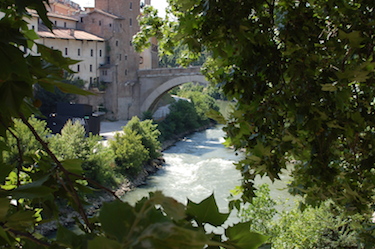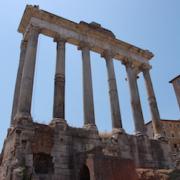 Overview
Overview
Rome, in our book, is in a neck-and-neck race with Paris for most romantic city in Europe. At one turn Rome can be as neat as a pin, but dusty and frenetic the next. It’s Mecca for the world’s billion-plus Catholics, the center of western culture for history buffs, and a prime source of some of the best food and wine in the world for everyone. Rome is one of our favorite cities, one that we declared on our first visit years ago would be one of the cities we’d always visit while on vacation in Europe (Amsterdam and Paris are the other two).
If you can spend a week or more in Rome, you’ll not run out of things to do or places to eat. If your schedule is tighter, try not to trim Rome below four days. The earlier in the summer you can visit the better: it can get oppressively hot in from late June until September.
What to See in Rome
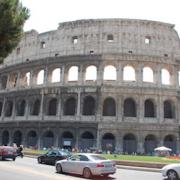 Attractions in Rome come in two basic categories: Roman ruins and Catholic-related. Nobody should visit Rome, even if only in town for a day, without seeing the Colosseum and Saint Peter’s Basilica. The Colosseum, technically “Flavian’s Ampitheatre”, is quintessential ancient Rome and lies just to the east of the ruins of the Roman Forum: hit both on the same day if you can. Saint Peter’s is the home church of the Holy See, the global headquarters of the Roman Catholic church: the grandest of all churches, it’s one of the best free-admission sights in the world. Unless you want to attend mass, try not to visit on Saturday evenings or Sundays.
Attractions in Rome come in two basic categories: Roman ruins and Catholic-related. Nobody should visit Rome, even if only in town for a day, without seeing the Colosseum and Saint Peter’s Basilica. The Colosseum, technically “Flavian’s Ampitheatre”, is quintessential ancient Rome and lies just to the east of the ruins of the Roman Forum: hit both on the same day if you can. Saint Peter’s is the home church of the Holy See, the global headquarters of the Roman Catholic church: the grandest of all churches, it’s one of the best free-admission sights in the world. Unless you want to attend mass, try not to visit on Saturday evenings or Sundays.
Our absolute top recommendation in Rome is to go on the Scavi Tour, the archaeological excavations beneath the basilica of Saint Peter. On this tour, you’ll be taken down into the necropolis adjacent to Nero’s Circus, purported to be where Saint Peter was buried after he was crucified, his grave the sight upon which the church was built. The tour requires reservations (without exception), sometimes (busy season) months in advance, so book early by clicking here. For an interesting read on our experience with the Scavi tour, read our blog on Chuck’s Dad’s last wish.
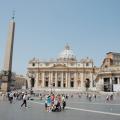 Everywhere you turn in Rome there are ancient ruins and buildings of interest, from obelists to the Spanish Steps, piazzas to the Trevi Fountain. It’s easy to wander aimlessly without a plan and come away with great memories and hundreds of wonderful photos. But for a more structured experience, we recommend you buy Rick Steve’s Rome guide book and follow his walking tours (he has great guided walks of many of Rome’s sights, so it’s well worth the investment).
Everywhere you turn in Rome there are ancient ruins and buildings of interest, from obelists to the Spanish Steps, piazzas to the Trevi Fountain. It’s easy to wander aimlessly without a plan and come away with great memories and hundreds of wonderful photos. But for a more structured experience, we recommend you buy Rick Steve’s Rome guide book and follow his walking tours (he has great guided walks of many of Rome’s sights, so it’s well worth the investment).
If you just can’t get enough of big, grand churches, you’re in the right place in Rome. You’ll find them everywhere (if you’ve always wondered why there are so many, click here). For a particularly grand experience, go to the Basilica of San Giovanni in Laterno: the pope is the Bishop of Rome, and this is his home cathedral (St. Peter’s is the seat of the Holy See, the HQ of the global church). While there, check out the nearby Scala Sancta, the steps Saint Helen took from the front of Pontius Pilate’s praetorium in Jerusalem, steps the faithful believe Jesus stood on during his trial. And for a quick fix of grand churches, find the Piazza del Popolo on the north end of town and its three splendid churches, the churches of Santa Maria of this, that, and the other thing (our nickname, not there’s).
stood on during his trial. And for a quick fix of grand churches, find the Piazza del Popolo on the north end of town and its three splendid churches, the churches of Santa Maria of this, that, and the other thing (our nickname, not there’s).
When it comes to museums, the must-see is of course the Vatican Museum, which will also get you in (through) to see the Sistine Chapel. The Vatican Museum is one of the top museums in the world, on par with the Louvre, Prado, and British Museums, chock full of art, so much so that at times it feels more like a warehouse than a museum. For a smaller but equally splendid experience, try the Borghese Gallery if you have time: you’ll find some of the greatest sculpture you’ve ever seen in this former cardinal’s mansion on the edge of one of Rome’s best parks (though you’ll be herded through like cattle).
Where to Stay in Rome
Rome is one of the cities of Europe where we’ve found a place to stay that we love so much we might not ever consider staying anywhere else while visiting Rome. It’s the Casa di Santa Francesca Romana, an active convent in a centuries-old Roman mansion. The nuns run a splendid hotel to fund their mission. Their courtyard is a wonderfully peaceful place to relax, and their building is interesting to explore (look for the chapel where the pope once said mass, and look for the unique paintings of the apostles).
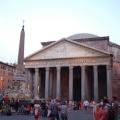 Casa di Santa Francesca Romana is in the Trestavere neighborhood of Rome, our favorite corner of Rome. If you can’t get into the convent, there are lots of lodging options in Trestavere. AirBnB boasts more than 1,000 in Rome overall, 650+ “Entire Place” listings in Trestavere alone.
Casa di Santa Francesca Romana is in the Trestavere neighborhood of Rome, our favorite corner of Rome. If you can’t get into the convent, there are lots of lodging options in Trestavere. AirBnB boasts more than 1,000 in Rome overall, 650+ “Entire Place” listings in Trestavere alone.
What and Where to Eat in Rome
Trestavere also happens to be the best neighborhood for dining in Rome, so you can enjoy an extra glass or two of wine with your lodging nearby. It’s true that there are great places all over Rome: just stop in somewhere that appeals to your nose while you’re out touring. We’ve even enjoyed the sumptuous McDonald’s on Piazza di Spagna (just south of the Spanish Steps), as much for the marble floors and walls as for the Big Macs (and “Royale’s with Cheese”). But for a couple of special Trestavere evenings, try al fresco dining at La Taverna dè Mercanti (“free show” in the evenings) and indoor dining at Carlo Menta, both an easy walk from Casa di Santa Francesca Romana.
